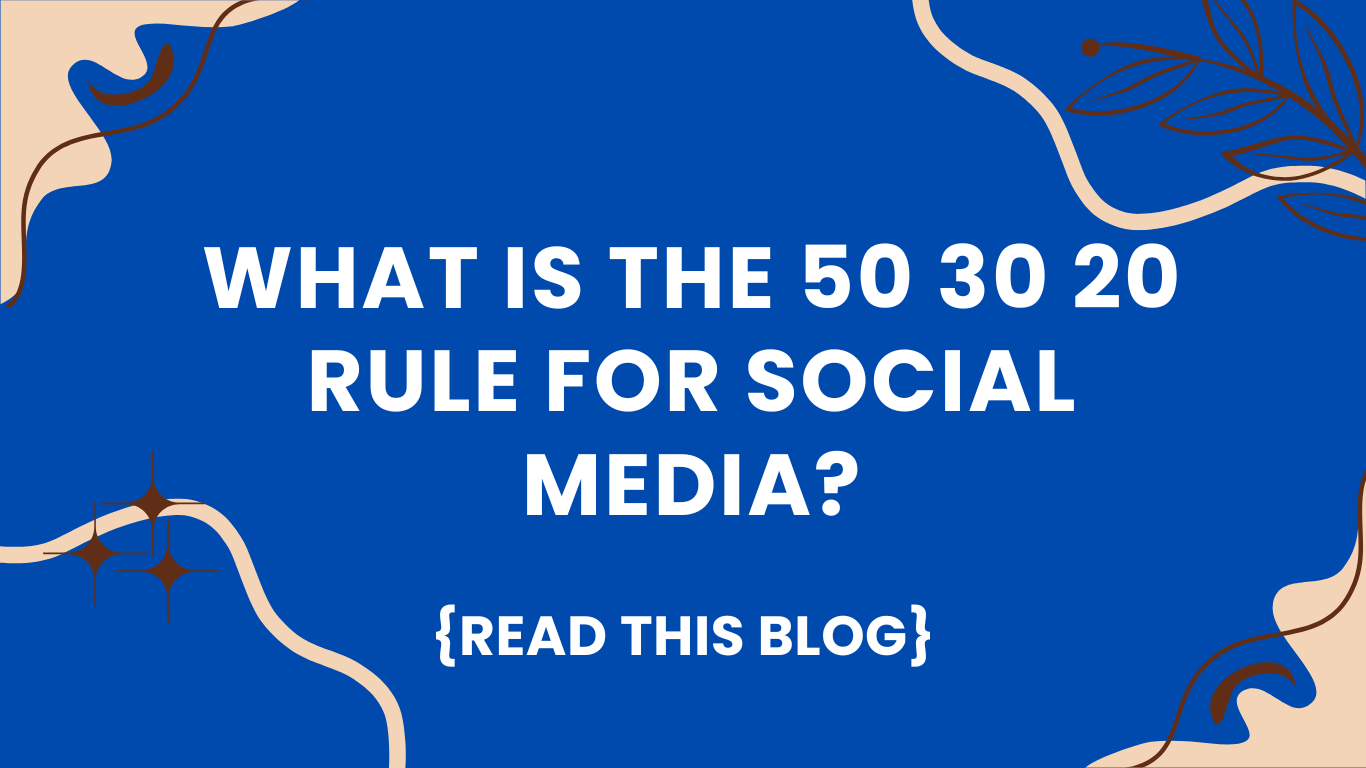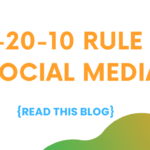
Rule for social media 50 30 20
Introduction to the 50-30-20 Rule:
The 50 30 20 rule for social media is a budgeting guideline that has gained popularity for its simplicity and effectiveness in personal finance management. It suggests allocating 50% of one’s income to needs, 30% to wants, and 20% to savings or debt repayment. However, this rule has garnered attention beyond finance, finding its way into the realm of social media strategy. The basic premise of the rule can be adapted to inform a structured approach to content creation and distribution in the digital landscape.
Table Of Content
- Breaking Down the 50% Content Strategy
- Exploring the 30% Engagement Approach
- Understanding the 20% Promotion Aspect
- Advantages of Implementing the Rule for social media
- Common Mistakes to Avoid When Applying the Rule for social media
- Tools and Resources for Implementing the 50-30-20 Rule
- Real-Life Examples of the 50-30-20 Rule in Action
- Conclusion: Final Thoughts on the Rule for social media
In social media management, the 50 30 20 rule for social media can be understood as a framework for balancing various types of content and engagement strategies. By applying this model, marketers and business owners can optimize their social media presence to achieve better audience engagement and brand awareness. The 50% allocation may comprise content that directly addresses the audience’s needs, such as informative posts, how-to guides, and industry insights that cater to the audience’s pain points. This content not only draws in followers but also establishes the brand as a trusted source of information.
The 30% allocation, representing wants, allows for creative and engaging content that resonates with the audience on a more personal level. This can include relatable stories, entertaining videos, and visually appealing imagery that encourages user interaction and sharing. Lastly, the 20% allocation focuses on promotional content aimed at driving conversions. This portion may cover advertisements, product launches, and special offers intended to turn followers into customers.
By utilizing the 50-30-20 rule in social media strategy, businesses can create a balanced content mix that enhances audience engagement while driving overall marketing goals. This structured approach ensures that brands can meet the diverse needs of their audience while maintaining a consistent and effective social media presence.
Breaking Down the 50% Content Strategy:
The 50% content strategy is an essential component of a successful social media plan, emphasizing the importance of informative, engaging, and educational posts. This segment of your social media content is vital for cultivating a relationship with your audience, ensuring that they receive value from your interactions. The primary aim is to create posts that resonate with followers, thereby fostering brand loyalty and establishing your presence as a thought leader in your industry.
Content within this 50% allocation can manifest in various forms, including articles, infographics, videos, webinars, and podcasts. Each type of content serves a unique purpose but collectively contributes to achieving your overarching social media goals. Informative posts, for instance, provide your audience with vital insights, industry news, and expert opinions that can help them make informed decisions. Educational content, such as “how-to” guides or tutorials, empowers your audience by teaching them new skills or knowledge related to your product or service.
Engaging posts aim to create interaction, prompting users to comment and share their opinions. Polls, quizzes, and questions can be excellent tools to spark engagement, as they encourage direct participation from your audience. Additionally, storytelling is a powerful method of engagement; sharing anecdotes related to your brand or customer experiences can significantly deepen connections with followers.
The importance of this strategic allocation cannot be overstated. By dedicating 50% of your content to posts that inform, engage, and educate, you not only provide value but also position your brand as reliable and knowledgeable. This approach nurtures trust and encourages followers to become advocates for your brand, ultimately driving sustained engagement and conversions.
Exploring the 30% Engagement Approach:
In the ever-evolving landscape of social media, the 30% engagement approach stands as a pivotal strategy for brands seeking to cultivate a vibrant online community. This portion of the content should aim to foster interaction with the audience, enhancing brand loyalty and retention. Engaging content is not merely an accessory; it forms the backbone of a successful social media strategy, as it actively invites users to connect with the brand on a more personal level.
To implement the 30% engagement rule effectively, brands can utilize various strategies such as polls, questions, and discussions. Polls serve as a quick and interactive way for audiences to voice their opinions on various topics related to the brand or its offerings. For instance, a clothing retailer might launch a poll asking followers to choose between two new outfit designs, which not only engages the audience but also provides valuable market insights that can inform future product developments.
Furthermore, posing questions in posts encourages dialogue. By asking open-ended questions about topics relevant to the audience’s interests, brands can stimulate conversations that draw in followers and promote a sense of community. This type of interaction signals to the audience that their opinions matter, reinforcing their connection to the brand.
Additionally, fostering discussions around trending topics or industry news can also keep the audience engaged. Hosting live Q&A sessions or forum-style discussions can lead to deeper connections, as customers feel valued and heard. The essence of the 30% engagement approach is about creating meaningful interactions that not only increase visibility but also promote customer loyalty. By valuing engagement within the content strategy, brands can build and sustain a loyal community that advocates for the brand, driving long-term success.
Understanding the 20% Promotion Aspect:
In the 50-30-20 rule for social media strategy, the final 20% of content is dedicated to promotional messages. This segment is crucial as it serves to market products or services, yet must be approached with caution to avoid overwhelming the audience with overtly sales-driven content. The key to effective promotion lies in maintaining a balance between promotional and value-driven content.
To craft promotional messages that resonate without feeling excessively commercial, brands can employ various techniques. First and foremost, it is essential to focus on storytelling. By weaving a narrative that highlights customer experiences, success stories, or the journey of product development, brands can showcase their offerings in a more relatable manner. This method not only provides information but also builds an emotional connection with the audience, making the promotional aspect feel more organic.
Additionally, utilizing user-generated content can enhance the authenticity of promotional messages. Encouraging customers to share their own experiences with a product or service can serve both as promotional material and social proof. This authentic content can be integrated into the promotional strategy, allowing potential customers to see real-world applications of the brand’s offerings.
Moreover, incorporating educational elements into promotional content can also enrich the audience’s experience. For instance, rather than simply advertising a product, brands can provide value by educating followers on how to use the product effectively or how it solves specific problems. This approach emphasizes the brand’s commitment to its customers’ needs and enhances the overall value proposition.
Ultimately, the 20% promotional content should be strategically crafted to maintain engagement while showcasing the brand’s offerings. By blending promotional messages with genuine value-driven content, brands can create a comprehensive social media strategy that not only drives sales but also fosters long-term customer relationships.
Advantages of Implementing the Rule for social media:
The 50-30-20 rule represents a strategic approach that divides your social media content into three distinct categories: 50% for engagement, 30% for promotion, and 20% for educational content. Adopting this framework offers several notable advantages that can significantly enhance a brand’s social media strategy.
One of the primary benefits is improved audience engagement. By allocating 50% of content to engaging posts, brands can foster interaction and dialogue with their audience. This interaction not only builds community but also enhances loyalty, as followers feel more connected to the brand. Engaged audiences are more likely to share content and recommend products, which can lead to increased organic reach and visibility.
Another advantage of this rule is clearer brand messaging. The 30% dedicated to promotional content allows brands to outline their core offerings succinctly and compellingly. This focused approach ensures that the audience understands the brand’s value proposition without feeling overwhelmed. Clear messaging reduces the risk of miscommunication and helps convey the brand’s identity, making it easier for potential customers to relate to the brand.
Furthermore, the 20% allocated to educational content plays a crucial role in enhancing customer relationships. By providing valuable information, brands position themselves as thought leaders in their industry. This not only boosts credibility but also enables customers to make informed decisions. When a brand demonstrates knowledge and expertise, it instills trust, which is essential for building long-term relationships with customers.
Ultimately, implementing the 50-30-20 rule can lead to better marketing outcomes. By creating a balanced content strategy that emphasizes engagement, clarity, and education, brands are well-positioned to achieve their social media goals and reach their target audience effectively.
Common Mistakes to Avoid When Applying the Rule for social media:
When implementing the 50-30-20 rule in a social media strategy, marketers often encounter specific pitfalls that can undermine their efforts. One common mistake is the oversaturation of promotional content. While the rule allows for a 20% allocation of promotional posts, failing to adhere to this guideline can lead to audience fatigue and disengagement. It is crucial to strike a balance, ensuring that the promotional content does not overshadow the engaging or informative posts. This requires careful planning and monitoring of post types to maintain an appropriate mix.
Another mistake to watch for is neglecting the significance of the 30% dedicated to engaging content. Marketers sometimes underestimate the value of interaction-driven posts, such as polls or questions. This section fosters community and builds relationships, which are essential for increasing brand loyalty and engagement rates. Without this interactive content, the strategy may fail to resonate with the target audience, ultimately diminishing its effectiveness.
Moreover, there can be a tendency to rigidly follow the 50-30-20 allocation without considering the nuances of the specific audience. Different demographics may respond variably to the type of content shared. Conducting regular analysis and adjustment of the content mix is vital to cater to audience preferences and behaviors. It is also beneficial to periodically reevaluate the goals achieved through this strategy to ensure alignment with overall marketing objectives.
Lastly, one must avoid the distinction between organic and paid content within the formula. While the 50-30-20 rule emphasizes the proportions, neglecting to integrate paid promotions with organic efforts can diminish their potential synergies. A coherent blend of both can maximize reach and engagement, leading to a more successful implementation of the 50-30-20 rule in social media strategy.
Tools and Resources for Implementing the 50-30-20 Rule:
To effectively implement the 50-30-20 rule in social media marketing, leveraging the right tools and resources is essential. This rule, designed to guide the allocation of content types in your social media strategy, can be significantly enhanced through the use of various digital platforms tailored for content creation, analytics, and management.
First and foremost, content creation tools play a crucial role. Platforms such as Canva and Adobe Spark offer user-friendly interfaces that allow marketers to create visually appealing graphics and videos without needing extensive design skills. Utilizing these tools can help ensure that the 50% of your content dedicated to engaging and entertaining posts is both high-quality and captivating, promoting greater interaction with your audience.
Next, when it comes to analyzing the performance of your posts, utilizing robust analytics platforms is indispensable. Tools like Google Analytics and Hootsuite Insights can provide invaluable data on how users engage with your content. This information can help marketers assess whether their emphasis on the entertainment and informational content categories (30% and 20%, respectively) is effective. By examining engagement metrics, such as likes, shares, and comments, marketers can refine their strategies for optimal impact.
Lastly, social media management software such as Buffer or Sprout Social can streamline your posting schedule. These platforms allow you to schedule posts in advance, ensuring a consistent presence on various channels, which is key to executing the different content categories outlined by the 50-30-20 rule. Additionally, many of these tools provide insights into audience preferences and peak engagement times, thereby enhancing your ability to reach your target demographics effectively.
By utilizing these tools and resources, marketers can systematically apply the 50-30-20 rule, tailoring their social media strategies to meet their objectives while fostering audience engagement and retention.
Real-Life Examples of the 50-30-20 Rule in Action:
The Rule for social media is a valuable framework that can effectively guide the social media strategies of brands and influencers. By allocating specific proportions of content types, various case studies exemplify how this strategy can enhance engagement and brand presence.
One compelling example is the global beauty brand, Glossier. By adhering to the 50-30-20 rule, Glossier effectively distributes its social media content. The 50% of Glossier’s posts focus on user-generated content, showcasing real customers using their products. This approach cultivates community and trust, essential elements in the beauty industry where authenticity reigns supreme. The 30% is dedicated to educational content, such as makeup tips and skincare routines, while the remaining 20% features promotional content, highlighting new product launches and special discounts. By striking this balance, Glossier has grown a loyal following and fostered an engaging online community.
Another noteworthy case is that of fitness influencer Kayla Itsines. Her strategy follows the same principle, where she shares 50% motivational posts featuring success stories and transformations from her followers, which inspires her audience. The 30% encompasses workout routines and nutritional advice, providing value to her followers. The last 20% targets promotional activities, such as advertising her workout guides or fitness programs. This combination not only motivates her audience but also converts followers into customers, proving the effectiveness of the 50-30-20 rule in boosting her brand’s visibility and sales.
Moreover, restaurants like Domino’s use the 50-30-20 rule by dedicating half of their social media posts to enticing food visuals and customer reviews, 30% to behind-the-scenes content that showcases their cooking and delivery processes, and 20% to promotions and special offers. This effective strategy has allowed Domino’s to maintain customer engagement while driving sales effectively.
Conclusion: Final Thoughts on the Rule for social media:
In our exploration of the 50-30-20 rule for social media strategy, we have highlighted the importance of balanced content distribution across different types of posts. This rule serves as a framework that encourages marketers and content creators to effectively engage their audience while maintaining a diverse and dynamic presence on social media platforms. By allocating 50% of content to informational and educational posts, 30% to promotional content, and 20% to personal and humanizing updates, brands can cultivate a well-rounded image that resonates with followers.
The significance of balance cannot be overstated. Brands that adhere to the 50-30-20 rule can foster not only engagement but also trust and loyalty among their audiences. Educational content demonstrates expertise, promotional posts inform audiences about offers, while personal updates create a relatable brand persona. This combination contributes to a more engaging social media strategy, ensuring that no single type of content overwhelms the followers.
Furthermore, implementing the 50-30-20 rule encourages marketers to evaluate their content strategies critically and make informed adjustments as necessary. As the social media landscape continues to evolve, adapting to changes in audience preferences and platform algorithms is essential. By consistently applying this structure, brands can refine their messaging and thus enhance audience retention and growth.
Ultimately, applying the 50-30-20 rule in your social media strategy can lead to enhanced success and greater fulfillment of marketing goals. Marketers are encouraged to take actionable steps toward leveraging this balanced approach, thereby maximizing their potential for impact in the digital space. By doing so, they will likely see improvements not only in audience engagement but also in overall brand perception.





Your blog is helping me rebuild my entire marketing plan.